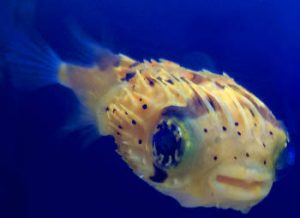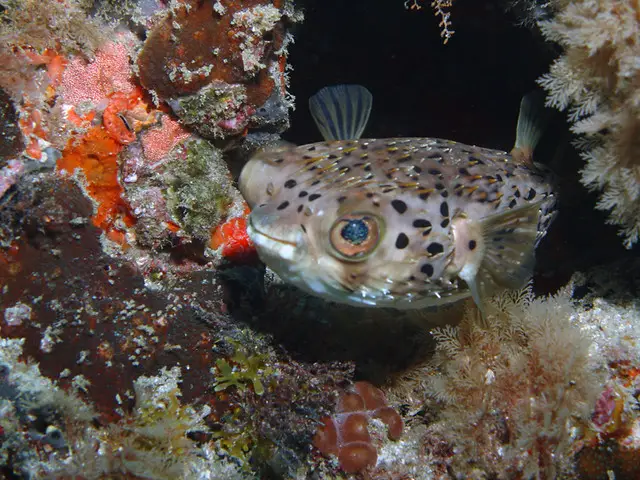
Diodon holocanthus
.
| Difficulty | Medium |
| Minimum Tank Size | 180 Gallons |
| Diet | Omnivore |
| Water Parameters | 72-78 F, pH 8-8.4, Salinity 1.020-1.025 |
| Aggression | Semi-Agressive |
| Size | 1' |
The Porcupine Puffer Fish is a fairly demanding, large fish with a personality to match. They sport the iconic spiky body everyone expects from the puffer and give their owners quite a bit of attention. The Porcupine Pufferfish will often learn about its owners and how to get their attention. Some have been caught spitting water out of tanks that are left open, as most aquarists jump at the sound of water splashing onto their floor.
Those giant friendly eyes are genuine, as this is one of the few puffer fish that is reef safe. By selecting the right tank mates, clean up crew and tank layout, the Porcupine Puffer can be fairly easy to care for and cause little to no issues.
Behavior & Aggression
Coming in at a foot in length, it’s no surprise that the Porcupine Puffer fish can interact with humans. As previously stated these fish bring a lot of personality to the tank and are a frequent favorite in large aquariums.
Overall they are not too aggressive, however they can eat fish that are small enough to fit in their mouths. Thankfully the tank they need is so large your options are not too limited. It is also important to note that not all fish behave the same. As I cannot keep Mandarins out of my tanks I wound up having the porcupine and Green Mandarin share a tank without any issue. whether this is due to a nicer puffer or a fast mandarin is a mystery. Still many aquarists do keep the Porcupine Puffer with smaller fish.
When choosing larger tank mates there isn’t too much to worry about. Even aggressive triggers will have a hard time harassing these guys, as their sharp spines will easily drive away most aggressors.
Remember: one foot is pretty dang big. Be sure your tank is no less than 24″ wide. larger tanks are recommended, however a 2 foot berth will give a full sized puffer enough space to turn. Don’t forget to keep your rockwork in mind when measuring the tank.

Diet & Feeding
A big thing to note here is how messy the Porcupine Puffer fish is when it comes to eating. Be sure your filtration is able to keep up with these guys, or simply net/vacuum out any excess food bits after feeding. Otherwise you will quickly find yourself with an algae bloom.
Honestly it feels like these guys eat two thirds of the food we give them and spread the rest around the tank. Using a strong canister filter or protein skimmer will dramatically cut down on the need for water changes.
A good Porcupine Puffer fish diet consists of:
- Hard shelled shrimp or frozen shrimp
- Clams
- Krill
- Squid
- Mussels
The hard foods are essential, as they will serve to grind down constantly growing teeth. Puffers will accept other soft foods like silverside and live shrimp, but these should be fed sparingly.
Porcupine Puffer Tank Needs
The Porcupine Pufferfish has a couple of special requirements that most tanks do not follow. For starters pufferfish must be kept in tanks with lower levels of copper. Unlike scaled fish which have an easier time regulating their copper balance, the Porcupine Pufferfish does not have scales and can easily get sick in a tank with too much copper. This means any tank that has been treated with copper can endanger a puffer.
There are a few simple steps you can take to keep the copper levels down in the aquarium.
- Feed the aquarium lower copper content foods
- Do not bring in hospital tank water
- Always use Reverse Osmosis, RODI, water
- Avoid water sources from copper pipes
Next up is iodine, a trace element found in most tanks. This will find its way into your tank through water changes, but can also be added to the tank with supplements. Porcupine Puffers are generally fine with little to no added iodine when the tank has water changes more than once a week. If the water is changed less often then you may need to add in some iodine.
So why is iodine important to the Porcupine Pufferfish? A deficiency in iodine can cause two different problems, lockjaw and thyroid issues. A big part of these issues is a non varied diet, but severe iodine deficiencies can play a role in developing these two issues.
For more info on pufferfish sickness check out wetwebmedia’s page about pufferfish.
Breeding & Sexing Porcupine Puffer
Porcupine Puffers are difficult to sex. The only sure fire way to determine their gender is to make the tank match their breeding needs. Once that has been done your puffer may or may not lay eggs. If you do find their eggs in the tank than you have a female. If not, and you are sure the tank is breeding ready, than you have a male. To be breeding ready your tank should:
- Be no smaller than 150 gallons
- Be well fed at regular intervals
- Have a consistent lighting schedule
- Be free from predators
- Not be overstocked with fish
Alternatively if you have two puffers and one is chasing the other, the chaser is likely male while the one being chased is female. These puffers know they are hard to bite and will not usually harass one another if they are the same gender.
As for the breeding portion it simply is not possible for the average aquarist. These fish are simply too large for their eggs to survive in captivity. As of the time of this writing, breeding in the home aquarium has not been reported.
Other Notes
Puffer fish will only inflate when they feel threatened. Because of this most owners will not see the act more than a few times. If you notice your puffer fish frequently inflated you may want to watch the tank from afar. Some bullying may be taking place behind your back. On the other hand if they only puff up when they notice you coming close it could be a ploy for attention. These guys are certainly smart enough to think of things like that.